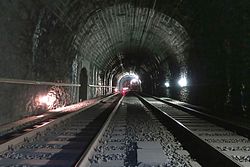Gotthard Rail Tunnel

Inside the tunnel
|
|
| Overview | |
|---|---|
| Official name | German: Gotthardtunnel, Italian: Galleria del San Gottardo |
| Line | Gotthard Railway |
| Location | Traversing the Saint-Gotthard Massif in the middle of the Swiss Alps |
| Coordinates | 46°35′44″N 8°35′44″E / 46.59556°N 8.59556°E |
| System | Swiss Federal Railways (SBB CFF FFS) |
| Start | Göschenen, canton of Uri (north, 1,106 m (3,629 ft)) |
| End | Airolo, canton of Ticino (south, 1,145 m (3,757 ft)) |
| Operation | |
| Work begun | September 13, 1872 |
| Opened | May 22, 1882 |
| Owner | SBB CFF FFS |
| Operator | SBB Infrastructure |
| Traffic | railway |
| Character | passenger, fright |
| Technical | |
| Design engineer | Louis Favre |
| Length | 15.003 kilometres (9.322 mi) |
| No. of tracks | Double |
| Track gauge | 1,435 mm (4 ft 8 1⁄2 in) (standard gauge) |
| Electrified | 15 kV 16.7 Hz since October 18, 1920 |
| Highest elevation | 1,151 m (3,776 ft) (inside the tunnel) |
| Lowest elevation | 1,106 m (3,629 ft) (north portal) |
| Tunnel clearance | 7.1 m (23 ft) |
| Width | 8.0 m (26.2 ft) |
| Route map | |
The Gotthard Tunnel (German: Gotthardtunnel, Italian: Galleria del San Gottardo) is a 15.003-kilometre-long (9.322 mi) railway tunnel and forms the summit of the Gotthard Railway in Switzerland. It connects Göschenen with Airolo and was the first tunnel through the Saint-Gotthard Massif in order to bypass the St Gotthard Pass. It is built as one double-track, standard gauge tunnel. When opened in 1882, the Gotthard Tunnel was the longest tunnel in the world.
The tunnel rises from the northern portal at Göschenen (1,106 metres (3,629 ft)) and the highest point (1,151 metres (3,776 ft)) is reached after approximately 8 kilometres (5.0 mi). After two more kilometers, the border between the cantons of Uri and Ticino is passed; after another 5 kilometres (3.1 mi), the tunnel ends at the southern portal near to Airolo (1,142 metres (3,747 ft)). The trip takes about seven to eight minutes by train. Services are operated by the Swiss Federal Railways.
In 1871 under the stewardship of the Swiss industrialist Alfred Escher, who had created the Schweizerische Kreditanstalt in 1856, the Gotthard Railway Company was founded. Despite initial difficulties to finance the project, and resulting costs of about 11% over budget, the financing was shared among private and public investors from Switzerland (20M CHF), Italy (45M CHF) and the German Empire (20M CHF). The bidding war between an engineering company from Geneva and Italy was fought viciously, and finally, the Swiss engineer Louis Favre won the project with an estimated cost of 2830 Swiss francs per meter. Because of his low bid, and the extra costs during construction, Favre increasingly found himself at odds with Swiss politicians and investors alike.
...
Wikipedia

